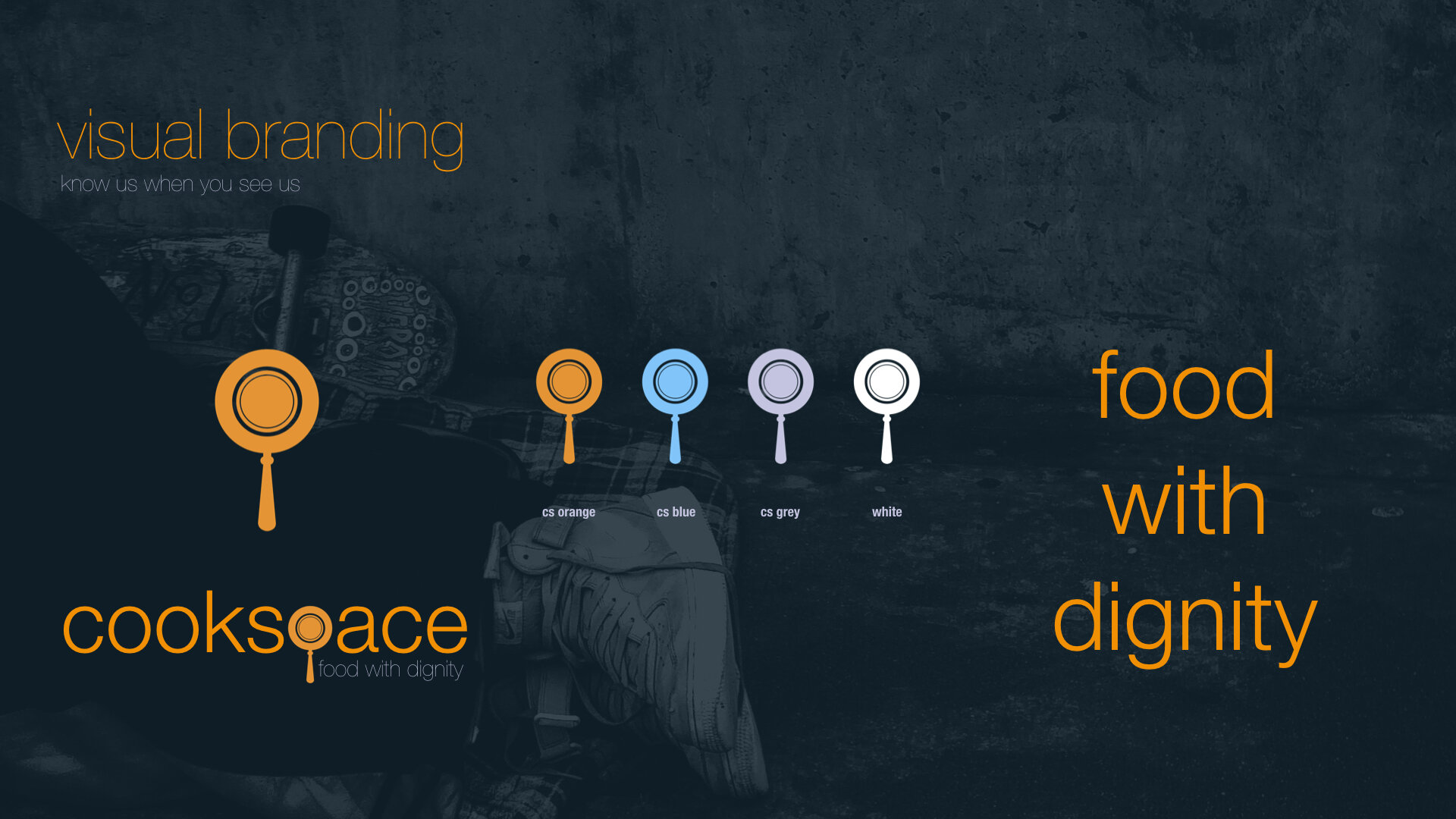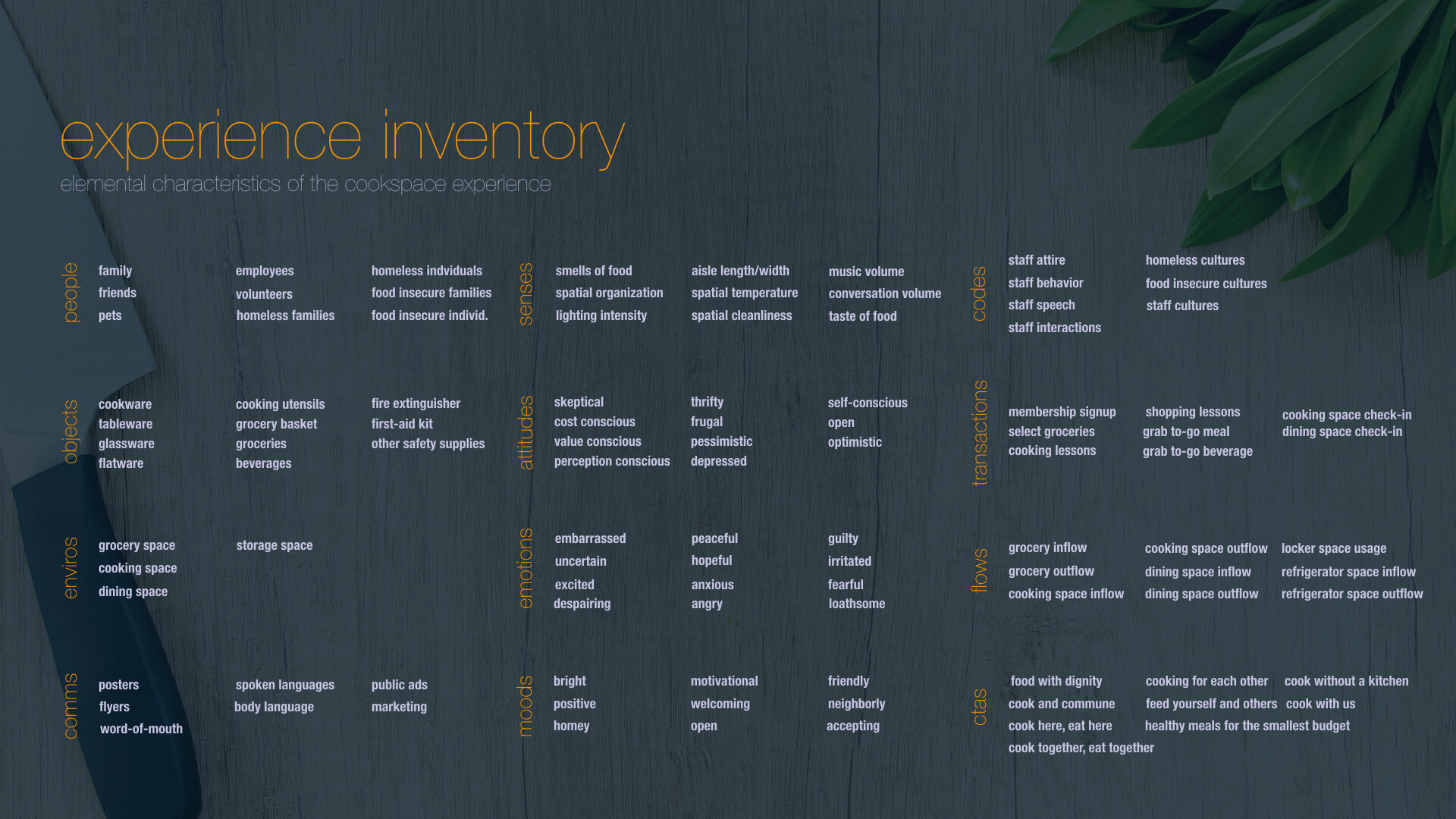Cookspace
Food with dignity.
COOKSPACE
Product Vision
Cookspace is a membership-based grocery store and communal cooking space for the homeless and food insecure within the New York City metro area. Powered by fresh foods that would be otherwise discarded by local grocery stores and quick service restaurants, Cookspace provides access to resources where these overlooked communities can purchase, cook, and enjoy nourishing meals. At Cookspace, there is no shame in being hungry.
To join Cookspace, simply enroll in the membership program, which provides access to the Grocery Space, the Cooking Spaces, the Dining Spaces, and the Refrigeration Spaces (refrigerated mini-lockers perfect for short-term storage of leftovers). Additionally, a Cookspace membership provides access to shopping and cooking lessons, where attendees can learn how to shop for and prepare healthy meals on the smallest budgets.
How it Works
The Cookspace offering blends accessibility to the raw ingredients of a grocery store with the flexibility of food preparation in a kitchen, affording people who cannot access either resource the budget-saving power of home cooking. A hungry person with $20 in their pocket and no access to a kitchen to cook their own meals must to go to a fast-food or fast-casual restaurant to feed themselves. Doing this, the $20 would only provide at most two meals. With Cookspace, that same person can access fresh raw foods and a stocked kitchen to prepare a meal that is both more nourishing and longer-lasting than the commercial food options. Cooking in bulk and eating leftovers will feed a person for several days, not just two meals.
Cookspace powers its offering by capitalizing on an existing inefficiency in the American food system. Grocery stores and fast-casual restaurants discard perfectly fresh food as it nears the sell-by date because they want customers to believe their products are as fresh as possible. However, foods that have reached their sell-by date are still good to eat, especially raw fruits and vegetables. Instead of discarding these foods, which the stores cannot sell, Cookspace collects and organizes them into the Grocery Space. Members can then come to the Grocery Space to pick out raw ingredients to prepare, eat, and store.
Cookspace members will have diverse backgrounds creating different sets of needs and manners of using the available spaces. Consequently, the offering anticipates several types of user journeys that share one common story arc: join, share, commune.
The first portion of the arc entails completing the registration required to join the Cookspace membership. The membership platform will feature both digital and analog interfaces, allowing members of different means to access and join. There is a small membership fee to cover operations, and to create for members a sense of empowerment in understanding that Cookspace is not a handout; rather, it is an environment with resources thoughtfully designed with them in mind. Access to Cookspace is also time boxed, allowing each person access to the spaces at most three times a day, for three hours from entry to exit. This maintains the Cookspace experience while making space available for as many members as possible.
The second portion of the Cookspace story arc comprises the four types of spaces we offer: Refrigeration Spaces, Kitchen Spaces, Grocery Spaces, and Dining Spaces.
Refrigeration Spaces are each approximately the size of a standard microwave, with shelving and organizational compartment designed for short-term storage of leftovers and perishable goods. By including these spaces we ensure that members have a temporary space of their own to preserve any leftovers they may have from cooking previous meals, allowing them to cook larger batches of food that they can eat from repeatedly.
Kitchen Spaces, the backbone of the Cookspace experience, are communal kitchens that members can check into and prepare meals in. Each Kitchen Space can be shared by at most two members, affording members the sentimental value of cooking with others. This feature is especially useful for homeless or food insecure families, as the Kitchen Space can be a place where they cook together as a family in spite of their circumstances.
If the Kitchen Spaces are the backbone of Cookspace, then the Grocery Space is the spinal cord itself. Stopping here to pick ingredients or take a shopping lesson on how to make the most of a tiny food budget, members will find great value in this space. Furthering the sense of community and congeniality are the Dining Spaces, which are designed for family-style dining. More than just a place to get food, Cookspace is a community of people with stories, wisdom, and experiences to share. Dining Spaces are designed to elicit exactly this type of friendship and camaraderie.
The Inspiration for Cookspace
Cookspace began as an idea to create a new generation of home cooks comprised of individuals who do not have access to a kitchen or grocery store. Initially, I examined how a homeless person might feel if they were to walk into a grocery store and quickly realized that I have never seen a homeless person inside of a grocery store. This made me wonder: what would a grocery store that caters the homeless feel like? This research question underpins the entire Cookspace experience framework.
How it came Together
Activities
Secondary Research
3 Analogous Audits
3 Competitive Audits
1 Ideation Session
1 Analogous Audit Synthesis
1 Competitive Audit Synthesis
1 Experience Inventory
1 Journey Map
1 Branding Session
1 Experience Frame
Tools
Microsoft Excel
Adobe Illustrator
The Noun Project
Keynote
The first element of the Cookspace experience framework is the experience inventory. This inventory lists all elements that can be used to create an experience, and includes everything from physical objects, like cookware, to abstract humanisms, like calls to action. To develop the Cookspace experience inventory, I conducted analogous audits of local grocery stores and created a master “grocery store experience inventory” comprised of all the elements that regular grocery stores, like Whole Foods and Traders Joe’s, use to execute their unique shopping experience. Additionally, I conducted competitive audits of places that homeless and food insecure people normally go to get food, soup kitchens, shelters, and food pantries, to create a master “food charity experience inventory”.
Drawing on elements in both master inventories, I crafted the Cookspace experience inventory, focusing first on elements that are operationally required for the purpose - one cannot have a kitchen without pots and pans - and iteratively delving into the intangible elements required to create an experience evoking senses of ownership, dignity, and surprise. The experience inventory presented is an abbreviated survey of everything required to create a space where people can feel empowered whilst feeding themselves, a sentiment directly opposing the status quo sentiment of the homeless and food insecure during their quest to secure the next meal.
The final portion of the story arc involves the ways in which members will use any or all of the spaces, and in what order. Communing with Cookspace is more than sharing a meal or taking a cooking lesson; it is every interaction and every ritual members form as they become more integrated into the physical and metaphysical spaces here. Regardless of how members use Cookspace, the underlying message is consistent: Cookspace, creates food with dignity.
Lessons Learned
Developing the Cookspace service concept and experience frame required lateral thinking to parse through and find commonalities between two seemingly unrelated experiences: the grocery store experience and the food pantry experience. Though both are places where people go to procure food, the manner in which users do so varies drastically in each context. Performing the analogous and competitive audits forced we to identify exactly which elements are used to create specific emotions, senses, and mindsets within a seemingly innocuous, but highly designed, space.
When visiting a grocery store or homeless shelter, one is not consciously examining the greetings from staff members or the size and arrangement of the space, but the brain perceives these things to create an unconscious experience that lives in the mind of person in the space. Taking a magnifying glass to the effect of isles and staff members on the human psyche as it peruses a store helped me to understand that designers cannot truly create an experience because the experience is a memory that exists in a person’s mind. We can, however, manipulate all of the elements in a space in such a way that a person may enter that space and have an experience on their own. This nuance in experience design was fascinating to observe and will be a facet of my experience design methodology that I will explore and develop going forward.
The Cookspace concept is a thoughtful exploration into food service experience design for an unconventional user and is positioned for further research, ideation, and testing. Taking this product to the next level will involve performing ethnographic research into the lived experiences of homeless and food insecure individuals trying to find their next meal to identify the specific problems they encounter and how those problems affect the experience of providing food for themselves and their families. I will then synthesize those findings into an as-is journey map of the target user’s experience, followed by a current state service blueprint to understand what homeless and food insecure individuals and families need to find food with dignity. This information allows me to refine the existing Cookspace journey map and use co-creation sessions to help my users design the experience that addresses their pain points while accommodating unspoken or unconscious needs as well.











